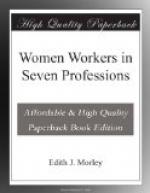Educational Inspectors.—There are now 1 Chief Woman Inspector, at a salary of L650; 45 Inspectors, 8 at L400-10-L500, and 35 at L200-15-L400.
The method of appointment of Women Inspectors’ is similar to that of men—i.e., by nomination of the President of the Board of Education. The Chief Woman Inspector first interviews candidates, weighs their qualifications, and reports upon them to the Secretary. There is no examination on appointment. Besides academic qualifications, which are the same as those of men, many of the Inspectors have special qualifications, as well as having had practical experience in teaching.
A special class of work is allotted to each Inspector: about 17 of them are occupied in inspecting Girls’ and Infants’ Public Elementary Schools: 15 are responsible for Domestic Subject Centres in Elementary Schools: 4 for Girls’ and Mixed Secondary Schools: 3 for Training Colleges (women’s and mixed): and 3 again for Domestic and Trade Courses and Girls’ Clubs.
In the case of secondary schools, the Women Inspectors pay special attention to women’s subjects, but they also take part in full inspections. They are not in charge of districts, and therefore do not carry on the miscellaneous correspondence with the Local Education Authorities which falls to the lot of a District Inspector. In relation to domestic subjects, however, the Women Inspectors are practically in charge of districts, and deal directly with Local Education Authorities. They inspect the work done by girls, and look into the organisation of the schools with regard to health, suitability of curricula, etc.
In the case of elementary schools, the Women Inspectors are attached to the various districts and are directed by the District Inspectors (men) as occasion requires, to deal with infants’ and mixed schools, and to carry out routine inspections of public elementary schools.
Medical Inspectors.—There are one Senior Medical Officer at L600-L800; one Junior Medical Officer at L400-20-L500; and also three Inspectors of Physical Exercises at L200-15-L400.
The Women Medical Inspectors take part in the work of the medical branch in the same way as men; Physical Exercises come under their jurisdiction.
The Board of Education also employs three women on the permanent staff of the Department of Special Enquiries and Reports. The salaries are L100-L7, 10s-L180, and the posts are pensionable. The duties consist partly of library work and partly of giving assistance in the general intelligence work of the office.




